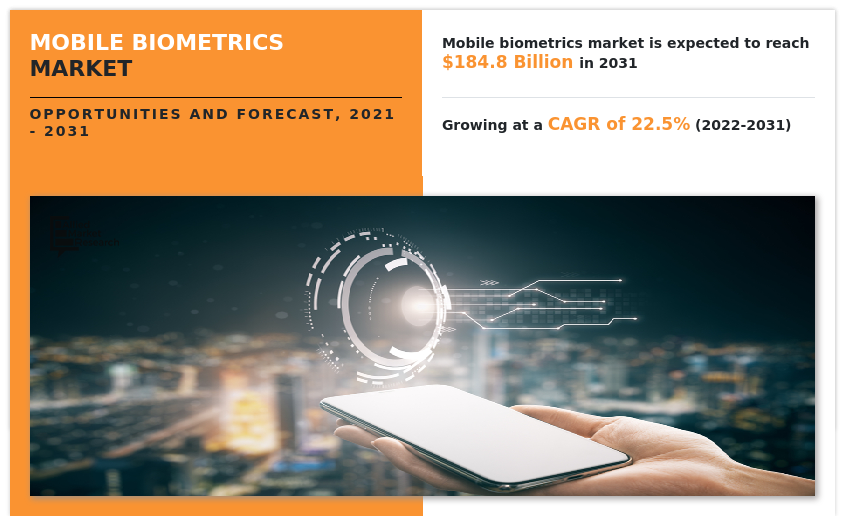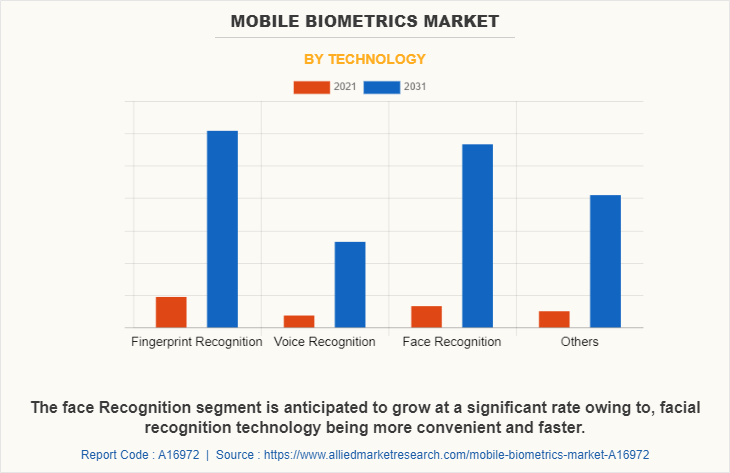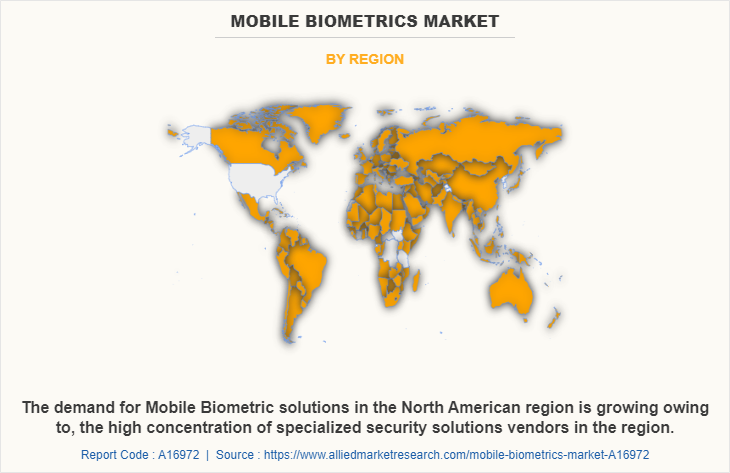Mobile Biometrics Market Research, 2031
The global mobile biometrics market share was valued at $24.6 billion in 2021, and is projected to reach $184.8 billion by 2031, growing at a CAGR of 22.5% from 2022 to 2031.
Rising demands for proper authentication methods are propelling the growth of the global mobile biometric market. Furthermore, rising number of cyber-attacks is also expected to aid in growth of the mobile biometric industry. However, complex installation and infrastructural requirements hamper the mobile biometrics market growth. Conversely, advancements in the field of IoT and cloud technology is expected to offer remunerative opportunities for expansion of the mobile biometric market during the forecast period.

Mobile biometric authentication is a type of authentication that use biometrics to identify and validate the identity of a person attempting to access a mobile application. With these mobile biometric devices, authentication can be done in a variety of ways, including fingerprint readers, face recognition, voice recognition, and others. Such factors are aiding in the adoption of mobile biometric devices.
The mobile biometrics industry is segmented on the basis of component, authentication mode, technology, industry verticals, and region. Based on component, the market is segmented into hardware, software, and service. On the basis of authentication mode, the market is bifurcated into single factor authentication and multi factor authentication. Depending on technology, the market is classified into fingerprint recognition, voice recognition, face recognition, and others. Based on industry verticals, the market is segmented into public sector, BFSI, healthcare, IT and telecommunication, and others. Region wise, it is analyzed across North America, Europe, Asia-Pacific, and LAMEA.
The key players profiled in the mobile biometrics market analsysis are 3M, Apple, Inc., Aware, Inc., BIO-Key International, HID Global Corporation, M2SYS Technology, NEC Corporation, Nuance Communication, Precise Biometrics AB, and Safran, Inc. These players have adopted various strategies to increase their market penetration and strengthen their position in the mobile biometrics industry.
Depending on technology, the fingerprint recognition segment dominated the mobile biometric market share in 2021, and is expected to continue this trend during the forecast period owing to fingerprint recognition systems being easier to deploy and maintain. However, the face recognition segment is expected to witness the highest growth in the upcoming years, owing to the improving facial recognition algorithms and advancements in the field of machine learning.

Region wise, the mobile biometric market was dominated by North America in 2021, and is expected to retain its position during the forecast period, owing to high concentration of mobile biometric solution vendors in the region, which is expected to drive the market for mobile biometric technology during the forecast period. However, LAMEA is expected to witness significant growth during the forecast period, owing to its growing digital and economic transformation and the developing communication network infrastructure in the region, which is expected to fuel growth of mobile biometric solutions in the region in the coming few years.

The report focuses on growth prospects, restraints, and analysis of the global mobile biometrics market trends. The study provides Porter’s five forces analysis to understand the impact of various factors, such as bargaining power of suppliers, competitive intensity of competitors, threat of new entrants, threat of substitutes, and bargaining power of buyers on the global mobile biometric market share.
Top Impacting Factors
Growing applications of biometric devices
The demand for biometric solutions are on a rise since the past few years, as with the growth of digital media and online content delivery, traditional methods of authentication such as signatures and text-based credentials are being proven to be harder for users due to such methods being highly vulnerable to modern cyber-attacks, such factors are positively affecting the mobile biometric market growth. Moreover, with the increasing number of digital services, users are in a desperate need to find quicker modes of authentication. Hence driving the need for mobile biometric authentication solutions.
However, over the past two years, the rising hygiene concerns and the increasing risk of the communal spread of coronavirus posed by touch-based biometric solutions have forced manufacturers to focus more on contactless biometrics technologies such as facial recognition and voice recognition. which is further helping in the expansion of mobile biometrics market by opening new avenues of growth.
Higher degree of security and assurance
Biometric solutions can provide an increased level of assurance to providers that a person is real by verifying a tangible, real-world feature that is unique (in most cases) to that particular individual such as fingerprints, facial attributes, voice articulation, among others. Traditionally, users would have to depend upon passwords or PINs and personal identifying information to authenticate themselves.
However, traditional credential-based authentication systems can be compromised with a data breach, meaning, billions of accounts can be accessed by fraudsters who retain the answers to traditional authentication methods. Introducing biometric authentication into the process adds in a roadblock for fraudsters that only a real, authorized user can move around - though a fraudster may know a person uses their dog’s name and some lucky numbers for most of their online accounts, while they still might not get to use the user’s fingerprint to unlock an account if they can’t provide it on the spot. Such applications of biometric devices are aiding in their adoption in more real world and mission critical operations.
COVID-19 Impact Analysis
The COVID pandemic has had an overall positive impact on the mobile biometric market, owing to a significant change towards the rise of digital retail and e-commerce platforms, which has resulted in increased engagement of online payments and a potential rise in cyber-attacks in the form of frauds and identity thefts. In such a scenario, strong authentication services for various banking and financial applications such as customer KYC and funds transfer are at call, and the use of high-quality security tools are essential.
In 2020, global investments in data security are increased by 2.4% to reach $123.8 billion. And with the growing awareness of data privacy and safety among users will probably influence organizations to be stricter with their security policies and help the global mobile biometric market to grow further in the coming years.
Key Benefits for Stakeholders
- The study provides an in-depth analysis of the global mobile biometrics market forecast along with current & future trends to explain imminent investment pockets.
- Information about key drivers, restraints, & opportunities and their impact analysis on global mobile biometrics market trends is provided in the report.
- Porter’s five forces analysis illustrates the potency of the buyers and suppliers operating in the industry.
- The quantitative analysis of the market from 2022 to 2031 is provided to determine the market potential.
Mobile Biometrics Market Report Highlights
| Aspects | Details |
| By Component |
|
| By Authentication Mode |
|
| By Technology |
|
| By Industry Vertical |
|
| By Region |
|
| Key Market Players | BIO-Key International, NEC Corporation, HID Global Corporation, Apple, Inc., 3M, Safran, Inc., Nuance Communications, Aware, Inc., Precise Biometrics AB, M2SYS Technology |
Analyst Review
Demand for mobile biometric systems has been increasing in past few years, and is expected to maintain this trend in the coming years as well, owing to growing fear of cyber-attacks and data breaches. Moreover, rising demands for privacy is expected to further drive the mobile biometric market. In addition, growth in digital and internet penetration in many regions of the world are promising new opportunities for growth of the mobile biometric market.
Key providers of the mobile biometric market such as HID Global Corporation, M2SYS Technology, and NEC Corporation account for a significant share in the market. With larger requirement from mobile biometric, various companies are establishing partnerships to increase their mobile biometric offerings. For instance, in February 2022, rf IDEAS, a leading manufacturer of credential readers for authentication and logical access announced partnership with ID R&D INC. a video biometrics services provider. With this partnership is rf IDEAS is adding biometric authentication to its portfolio strengthening security and reduces user friction.
In addition, with increase in demand for mobile biometric, various companies are expanding their current product portfolio with increasing diversification. For instance, in May 2022, Mastercard announced launch of Biometric Checkout Program. With this new program Mastercard unleashes new era of biometric payments to enhance the checkout experience. The program was initiated as a trail in Brazil with Payface and St Marche.
Moreover, market players are expanding their business operations and customers by increasing their acquisition. For instance, in October 2021, Prove Identity, Inc. announced acquisition of UnifyID, a mobile-based passive authentication and behavioral biometrics services provider. With this acquisition Prove customers will benefit from revolutionary, award-winning modern authentication technology and the addition of the industry’s brightest AI/ML talent.
Rising demands for proper authentication methods are propelling the growth of the global mobile biometric market. Furthermore, rising number of cyber-attacks is also expected to aid in growth of the mobile biometric industry.
Region wise, the mobile biometric market was dominated by North America in 2021, and is expected to retain its position during the forecast period, owing to high concentration of mobile biometric solution vendors in the region, which is expected to drive the market for mobile biometric technology during the forecast period.
The global mobile biometric market size was valued at $24.63 billion in 2021, and is projected to reach $184.81 billion by 2031, growing at a CAGR of 22.5% from 2022 to 2031.
The key players profiled in the mobile biometric market analysis are 3M, Apple, Inc., Aware, Inc., BIO-Key International, HID Global Corporation, M2SYS Technology, NEC Corporation, Nuance Communication, Precise Biometrics AB, and Safran, Inc. These players have adopted various strategies to increase their market penetration and strengthen their position in the industry.
Loading Table Of Content...


